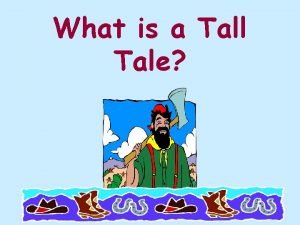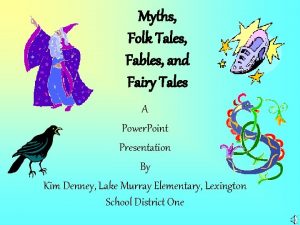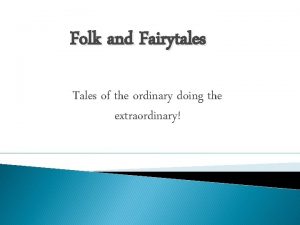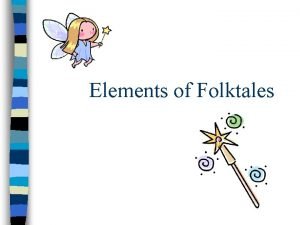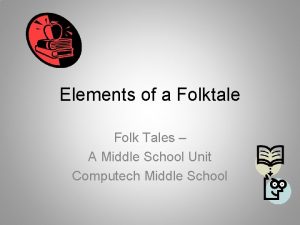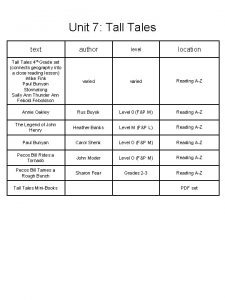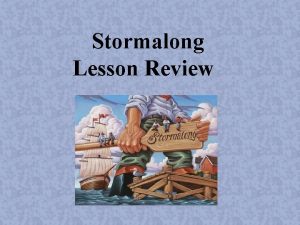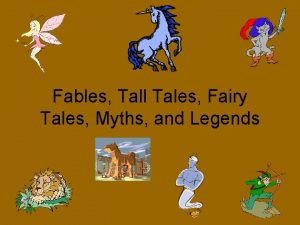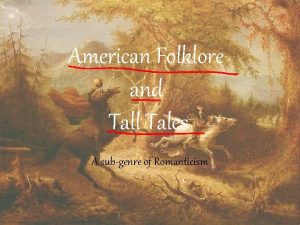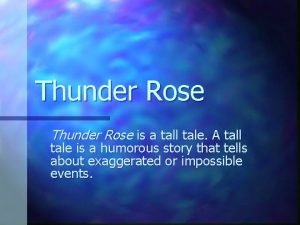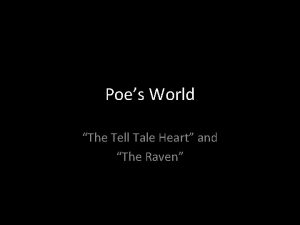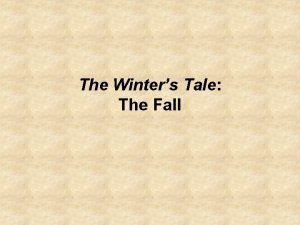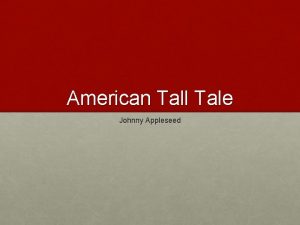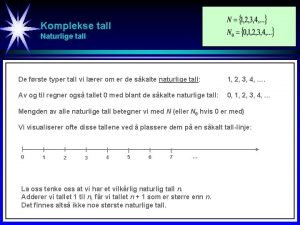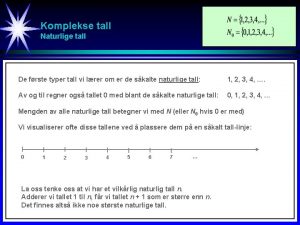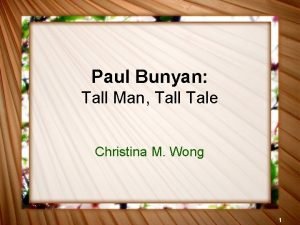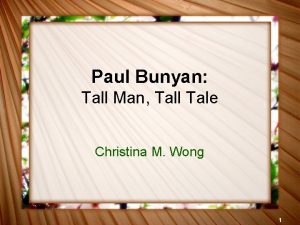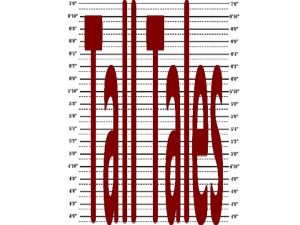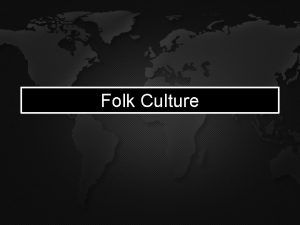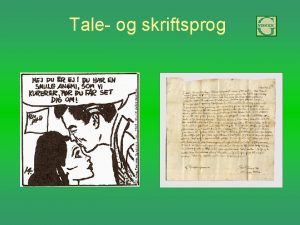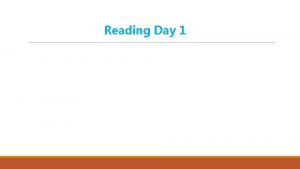CHARACTERISTICS OF A FOLK or TALL TALE SIXTH




















- Slides: 20

CHARACTERISTICS OF A FOLK or TALL TALE SIXTH GRADE ESL L. NABULSI

Definition of a Folk Tale • A tall tale is a story that has these features: – A larger-than-life, or superhuman, main character with a specific job. – A problem that is solved in a funny way. – Exaggerated details that describe things as greater than they really are. – Characters who use everyday language.

Origins of the Folk Tale • people depended on storytelling for entertainment. After a long day's work, people gathered to tell each other funny tales. • Origins in ORAL literature

Samples of Folk Tales • • • Robin Hood Pecos Bill Paul Bunyon Daniel Boon John Henry

Characteristics of Folk Heroes • A larger-than-life, or superhuman • main character with a specific job. • Characters who use everyday language.

Helpers of Folk Heroes • Usually animals – Babe, the Blue Mule • Special Weapon – King Arthur’s Excalibur • Special Friend – Little John, friend of Robin Hood

Antagonist of Folk Hero • Can be a person • Can be a event in nature • Can be an evil spirit

AMERICAN FOLK HEROES

Paul Bunyan • There have been few characters of American folklore with the stature of Paul Bunyan. This legendary hero of lumberjacks throughout American possessed strength, speed, and skill that matched the vastness of North American. • According to legend, Paul Bunyan and his giant blue ox, Babe, left many a mark on the landscape, receiving credit for creating Puget Sound, the Grand Canyon, and the Black Hills, among others. • Some folklore experts have credited the French-Canadians for starting the tales. Others attribute the tales to a Western logging company during the early 20 th century. Still others consider it a European import. • All agree, however, that Bunyan legend probably grew as the tales about him grew, bringing a new meaning to the term "tall story. " Stories about Bunyan and Babe first circulated through the logging camps of Michigan, Wisconsin, and Minnesota, where loggers first heard and then retold the fables, adding local or personal embellishments.

Johnny Appleseed • For forty-nine years, John Chapman ("Johnny Appleseed") roamed the American wilderness, devotedly planting apple trees. The reason for John's mission is unknown, although it's said he dreamed of a land covered with blossoming apple trees; of a land where no one went hungry because apples were plentiful. • John's gentleness and courage were legendary even in his own time. He walked alone in the wilderness, without gun or knife. He chopped down no trees, and killed no animals. He was respected and appreciated by the Native American tribes and the new settlers alike. • John lived very simply. He slept outdoors, walked barefoot and ate berries. He made his clothes from sacks and wore a tin pot for a hat (and to cook with). John made his drinking water in winter by melting snow with his feet. Even the people of his time were amazed at his endurance.

Pecos Bill • a legendary cowboy folk hero. According to legend, coyotes raised Pecos Bill after he fell from his parent's wagon. It was during his early years with the coyotes, that Pecos Bill befriended wild animals. • His relationships with those animals carried into adult life. He chose riding a mountain lion instead of a horse. When he did change mounts, Bill naturally selected a horse no one else could ride and named him Widow Maker. When it came to weapons, he nearly always chose a whip - not made of braided rawhide, but a live rattlesnake. • The only woman to catch Bill's fancy was Slue-Foot Sue, whom he met as she rode a catfish the size of a whale down the Rio Grande. This was; of course, before Pecos Bill drained the Rio Grande to water his ranch during and enduring drought.

John Henry • The legend of John Henry came about during the railroad boom era of the early 1800 s. John Henry, according to legend, "was a steel-driving African-American man, " who could hammer railroad spikes faster than anyone, and loved it. This Paul Bunyan-like character was born fullsized (over eight feet tall!) and went to work on the railroad when he was only three weeks old. Eventually, John Henry is challenged to compete against a steeldriving machine, to see who is better, man or machine. . . John Henry wins, but collapses, dead, at the finish line. John Henry "didn't really die. . . just stopped livin' in his Mammy's shack, and started livin' in the hearts of men, forever and a day. " The point is, as John says, a man can do anything if he puts his mind to it.

Writing a Folk Tale • • • Step One - Create a hero using the characteristics of such a hero. Exaggeration is the key. What do you want to exaggerate about this hero? Use the story pattern to help in writing your own Tall Tale. __________was the ________________ (Name of tall tale hero) (describing words like: toughest, smartest) man/woman in the state of ___________. Everyone for (state name) miles around knew ___________ and loved to tell and (hero's name) retell of his/her amazing feats.

Create a Situation • Step Two - Now you need an adventure for your tall tale hero. Once again, the key is to EXAGGERATE. The main event of a tall tale is not something that can happen in real life.

Create the Problem • Everyone for miles around knew _____(hero's name) • ______ and loved to tell and • • retell of his/her amazing feats. Now one day ___________(hero's name) • • went to visit ____(2 nd character)_____. _________. (2 nd character's name) • • Was having big problems with _________________

Create the Solution • Step Three: Using exaggeration create an unbelievable solution to the problem that is unrealistic. _______ explained his/her problem. That was all it took. Right away, ___________

Conflicts of Folk Hero • Man verses man - hero opposing another person perhaps in a contest • Man verses nature - exaggerated weather condition; animal • Man verses society - element bringing social change, social concept or moral • Man verses self - test of courage, strength, skill, endurance

Settings of Folk Tales • Time - at the time of • Place - where the folk the narrator (Narrator hero can prove is always an admirer himself through his of the folk hero. We work see the folk hero • Place and time are through the eyes of an associated with his admiring narrator). job.

Symbols in Folk Tales • Weapon/tool of work • Animal helpers • Objects related to power and strength

Practice • Fuji Flyer – – Mechanic who can spin the propellers with his arms Lift planes up to the ___sphere Pilot who can fly faster than ____ Air controller who can blow a plane back on course • Yakota Air Base possible problems – Earthquake – Typhoon – Invasion
 Folk tale characteristics
Folk tale characteristics Where is the setting of the folktale
Where is the setting of the folktale Peter piper tongue twister
Peter piper tongue twister Rubber baby buggy bumpers tongue twister lyrics
Rubber baby buggy bumpers tongue twister lyrics What is a tall tail
What is a tall tail Example folktale
Example folktale What are the key elements of a folklore
What are the key elements of a folklore Folk tale
Folk tale Elements of folktales
Elements of folktales Elements of a folk tale
Elements of a folk tale Stormalong an american tall tale answers
Stormalong an american tall tale answers Stormalong tall tale
Stormalong tall tale Tall tale examples in literature
Tall tale examples in literature Legends and fables
Legends and fables American folklore characters
American folklore characters Whats a tall tale
Whats a tall tale The tall tale heart
The tall tale heart A tall winter's tale
A tall winter's tale Nuast school holidays
Nuast school holidays Sixth form college windsor
Sixth form college windsor Walton high sixth form
Walton high sixth form




